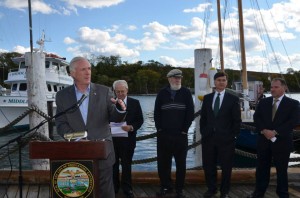A former Bridgeport landfill may be the site of a new green energy park for five megawatts of either solar, fuel cell or wind installations, pending approval.
The energy released would be enough to power 3,000 homes annually and save 366,880 metric tons of greenhouse gas emissions over 20 years.
Roughly five years ago city officials released a green energy request for proposals on the site, but with recent legislation allowing utility companies to operate renewable energy plants, plans for the park are finally taking off with United Illuminating at the helm.

“Solar is not as easy to do in New England as it is in say the southwest where they have consistent sun,” said Michael West, a spokesperson for United Illuminating. “We don”™t really have that, which means solar has not caught on as much as it has in other part of country. But this is an opportunity to provide clean energy to customers, which is something customers have been asking for.”
To increase energy competition, the Connecticut Legislature deregulated the state”™s energy market in 2000, forcing utility companies like UI and Connecticut Light & Power to sell off its power plants and operating companies. But in an effort to bolster renewable energy projects, the Legislature passed a bill in 2011, allowing the utilities to put a hand back in the game. Distributers are now allowed to own and operate a total of 10 megawatts worth of renewable energy.
The project in Bridgeport, located between Captain”™s Cove and Seaside Park, will be UI”™s first renewable energy project. West said the company may evaluate more opportunities as they appear. For now, UI must submit designs and a budget to the Public Utilities Regulatory Authority for approval. The park could be built as soon 2014.
“Our world is changing and there are many different ways and new technologies to bring customers options in electric and natural gas,” West said. “We”™re trying to stay on the cutting edge of that, while understanding our customers”™ needs and fulfilling them in a cost-effective way.”
West said it was too early to say what kind of energy would be installed at the park, what the cost would be, or what potential savings customers might see in the future.
Used for most of the 20th century, the landfill spans 50 acres by 100 feet deep, said Ted Grabarz, Bridgeport”™s sustainability director. It closed in 1997; it had been primarily used for construction debris. Now, however, the city hopes to use the former dump to continue its BGreen 2020 sustainability initiative to reduce energy consumption and greenhouse gas emissions.
“This is a key plank in the mayor”™s platform for sustainability,” Grabarz said. “It”™s going to give a great sense of visibility to the outside world as well.”
The city should soon be host to the largest fuel cell plant in North America ”” a 14.9 megawatt facility to be built by Virginia-based Dominion Resources Inc. in 2014 in the city”™s west end ”” and home to some of the few solar panel parks in the Northeast. The city has also initiated panel installations on six schools and six other buildings in the city.
Once the prototype for the UI project is under way, Grabarz said he believes officials may push for a high limit on the number of megawatts utility companies will be allowed to operate.
“The utilities will offer, over time, scalability we probably can”™t offer as a municipal or for individual residences,” Grabarz said. “They have the infrastructure in place to put solar into parks that commercial building wouldn”™t be able to whether it”™s because they aren”™t south-facing or are covered by trees.
“I think it would be very positive to expand the limit,” he said.






















